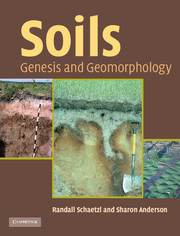Book contents
- Frontmatter
- Contents
- Preface
- Acknowledgements
- Part I The building blocks of the soil
- 1 Introduction
- 2 Basic concepts: soil morphology
- 3 Basic concepts: soil horizonation … the alphabet of soils
- 4 Basic concepts: soil mineralogy
- 5 Basic concepts: soil physics
- 6 Basic concepts: soil organisms
- 7 Soil classification, mapping and maps
- Part II Soil genesis: from parent material to soil
- Part III Soil geomorphology
- References
- Glossary
- Index
4 - Basic concepts: soil mineralogy
from Part I - The building blocks of the soil
- Frontmatter
- Contents
- Preface
- Acknowledgements
- Part I The building blocks of the soil
- 1 Introduction
- 2 Basic concepts: soil morphology
- 3 Basic concepts: soil horizonation … the alphabet of soils
- 4 Basic concepts: soil mineralogy
- 5 Basic concepts: soil physics
- 6 Basic concepts: soil organisms
- 7 Soil classification, mapping and maps
- Part II Soil genesis: from parent material to soil
- Part III Soil geomorphology
- References
- Glossary
- Index
Summary
Minerals are naturally occurring inorganic compounds that have a characteristic chemical composition and a regular, repeating three-dimensional array of atoms in a crystal structure. Minerals can be classified according to their chemical composition and crystal structure, or according to whether they are primary (inherited from the parent material without chemical alteration) or secondary (formed by chemical weathering of other, pre-existing minerals). Primary minerals tend to dominate in coarser size fractions, whereas secondary minerals are most abundant in the clay and fine silt fractions (Fig. 2.3). Knowing the structure and properties of soil minerals is essential for understanding the mineral transformation (including weathering) and transport processes that are important in soil genesis. This chapter emphasizes mineral structure, classification, properties, occurrence and identification, whereas later chapters (especially Chapters 13 and 15) focus on the role of minerals in soil genesis and geomorphology, e.g., as indicators of soil age or paleoenvironments.
Bonding and crystal structures
Understanding the chemical and structural classification of minerals requires knowledge of bonding and crystal structure in inorganic solids, particularly solids in which O2− is the anion. Oxygen (in the form of the oxyanion O2−) makes up about 47% (by mass) of the Earth's crust. It is by far the most abundant element in the crust (Fig. 4.1). Consequently, nearly all major groups of soil minerals, including silicates, oxides, phosphates, carbonates and sulfates, are ionic solids in which O2− is the primary anion.
- Type
- Chapter
- Information
- SoilsGenesis and Geomorphology, pp. 54 - 81Publisher: Cambridge University PressPrint publication year: 2005
- 1
- Cited by



